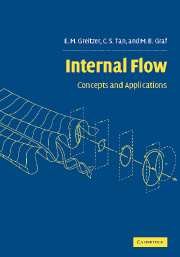Book contents
- Frontmatter
- Contents
- Preface
- Acknowledgements
- Conventions and nomenclature
- 1 Equations of motion
- 2 Some useful basic ideas
- 3 Vorticity and circulation
- 4 Boundary layers and free shear layers
- 5 Loss sources and loss accounting
- 6 Unsteady flow
- 7 Flow in rotating passages
- 8 Swirling flow
- 9 Generation of streamwise vorticity and three-dimensional flow
- 10 Compressible internal flow
- 11 Flow with heat addition
- 12 Non-uniform flow in fluid components
- References
- Supplementary references appearing in figures
- Index
8 - Swirling flow
Published online by Cambridge University Press: 14 January 2010
- Frontmatter
- Contents
- Preface
- Acknowledgements
- Conventions and nomenclature
- 1 Equations of motion
- 2 Some useful basic ideas
- 3 Vorticity and circulation
- 4 Boundary layers and free shear layers
- 5 Loss sources and loss accounting
- 6 Unsteady flow
- 7 Flow in rotating passages
- 8 Swirling flow
- 9 Generation of streamwise vorticity and three-dimensional flow
- 10 Compressible internal flow
- 11 Flow with heat addition
- 12 Non-uniform flow in fluid components
- References
- Supplementary references appearing in figures
- Index
Summary
Introduction
Many fluid machinery applications involve swirling flow. Devices in which swirl phenomena have a strong influence include combustion chambers, turbomachines and their associated ducting, and cyclone separators. In this chapter, we examine five aspects of swirling flows: (i) an introductory description of pressure and velocity fields in these types of motion; (ii) the increased capability for downstream conditions to affect upstream flow; (iii) instabilities and propagating waves on vortex cores; (iv) the behavior of vortex cores in pressure gradients; and (v) viscous swirling flow, specifically the influence of swirl on boundary layers, jets, mixing, and recirculation. The behavior of vortex cores ((iii) and (iv)) is described in some depth because this type of embedded structure features in a number of fluid devices. Further, much of the focus is on inviscid flow because the dominant effects of swirl are inertial in nature.
In the discussion it is necessary to modify some of the concepts developed for non-swirling flow. For example, there can be a large variation in static pressure through a vortex core at the center of a swirling flow, in contrast to the essentially uniform static pressure across a thin shear layer or boundary layer in a flow with no swirl. This pressure variation affects the vortex core evolution. The length scales which characterize the upstream influence of a fluid component are also altered when swirl exists.
Different parameters exist in the literature for representing the swirl level in a given flow. These have been developed to enable the definition of flow regimes and behavior.
- Type
- Chapter
- Information
- Internal FlowConcepts and Applications, pp. 389 - 445Publisher: Cambridge University PressPrint publication year: 2004



